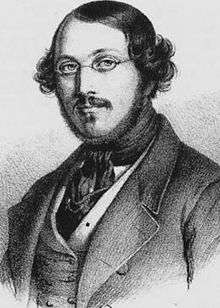Georg Carstensen
Johan Bernhard Georg Carstensen (31 August 1812 – 4 January 1857) was one of the developers of Tivoli Gardens and a Danish army officer. He spent most of his childhood in the Near East. He travelled widely and had a career in the military Royal Guards, reaching the rank of lieutenant. He attended boarding school at Herlufsholm kostskole.[1]
Georg Carstensen | |
|---|---|
 Georg Carstensen, 1845 | |
| Born | August 31, 1812 |
| Died | January 4, 1857 (aged 44) |
| Allegiance | Danish |
| Service/ | Army |
| Rank | Lieutenant |
| Unit | Royal Guards |
In 1839, Carstensen moved to Copenhagen permanently and published the periodical publications Portefeuillen and Figaro.[1]
Between 1843 and 1848, Carstensen was active in the development of Tivoli Gardens and Casino Theatre (Copenhagen) after which he joined the war at Schleswig. He learned that he was no longer required in Tivoli shortly after he returned. He was thought to have abandoned the project as he didn't extend the license of the construction.[2]
Following the disagreement with others in the Tivoli Gardens management, Carstensen travelled to the Danish West Indies and joined the army there.[1] He was married to the daughter of an island planter and assisted in management of the property. He subsequently spent time in New York City where he designed the New York Crystal Palace – an exhibition building constructed for the Exhibition of the Industry of All Nations in 1853 – in collaboration with the German architect Charles Gildemeister.[3]
Alhambra
In 1855, Carstensen returned to Copenhagen and attempted to construct an establishment to rival Tivoli Gardens, the Alhambra in Frederiksberg. The only reminiscent left of this failed project is a street named Alhambravej. The establishment failed to be completed during Carstensen's lifetime. He died 4 January 1857 at age 44 and was buried in Garnison's Churchyard in Copenhagen.[2]
Relatives
Georg's sister, Annette Adelaide Christine Carstensen, was the mother of Sir Robert Hay-Drummond-Hay, whose second wife Grace Marguerite Hay Drummond-Hay was the first woman to travel airborne from Europe to the US as well as the first woman to circumnavigate the globe in the air. Both of these were achieved aboard a Zeppelin.[4]
References
- http://www.tivoli.dk/en/om/historie/tivolis+grundlaegger/ Archived 2015-05-23 at the Wayback Machine retrieved 27 Jan 2015
- https://www.findagrave.com/memorial/95897725 retrieved 27 Jan 2015
- http://digital.lib.umd.edu/worldsfairs/record?pid=umd:989 retrieved 27 Jan 2015
- http://www.airships.net/lady-grace-drummond-hay retrieved 27 Jan 2015